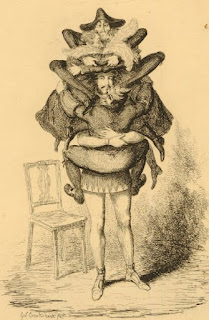The Great Belzoni’s powerful physique helped him remove Egyptian treasures
 |
| A portrait of Giovanni Belzoni during his time as an archaeologist in Egypt |
He became famous for his height and strength and his discovery and removal to England of the seven-ton bust of Ramesses II.
Belzoni was born into a poor family. At the age of 16 he went to find work in Rome and studied hydraulics. He was planning to take monastic vows but in 1798 French troops occupied the city and he moved to the Batavian Republic, now the Netherlands, where he earned his living as a barber.
He moved to England in 1803, allegedly to escape going to prison. He was six feet seven inches tall and had a powerful physique. For a while he earned his living as a circus strongman under the name, The Great Belzoni.
He also exhibited his models of hydraulic engines and went to Cairo in 1815 to offer hydraulic engines for use in irrigation to Muhammad Ali Pasha, the founder of modern Egypt.
But two years later he embarked on another new career, excavating Egyptian tombs and temples for their treasures. It was said he damaged other less valuable objects in the process, which was later frowned upon.
 |
| The 6ft 7ins Belzoni pictured as a circus strongman in England |
While he was in the process of removing an obelisk from the Nile island of Philae, it was taken from him at gunpoint by men working for the French.
He explored an island in the Nile, known as Elephantine, and the temple of Edfu. He also cleared the entrance to the great temple of Ramesses II at Abu Simbel. He was the first to penetrate the pyramid of Khafre at Giza and he identified the ruins of the city of Berenice on the Red Sea.
Belzoni returned to England in 1819 and published an account of his adventure – Narratives of the Operations and Recent Discoveries Within the Pyramids, Temples, Tombs and Excavations in Egypt and Nubia. It was a two-volume work published in 1820.
The explorer and archaeologist died in 1823 at the age of 45 in Gwato, now called Ughoton, in Nigeria on his way to Timbuktu. In 1825 Belzoni’s widow exhibited his drawings and models of the Royal tombs of Thebes in London and Paris.
 |
| The Scrovegni Chapel is one of the many attractions of the city of Padua |
Padua in the Veneto is one of the most important centres for art in Italy and home to the country’s second oldest university. Padua has become acknowledged as the birthplace of modern art because of the Scrovegni Chapel, the inside of which is covered with frescoes by Giotto, an artistic genius who was the first to paint people with realistic facial expressions showing emotion. His scenes depicting the lives of Mary and Joseph, painted between 1303 and 1305, are considered his greatest achievement and one of the world’s most important works of art. At Palazzo Bo, where Padua’s university was founded in 1222, you can still see the original lectern used by Galileo and the world’s first anatomy theatre, where dissections were secretly carried out from 1594.
 |
| The Prato della Valle square in Padua was built on the site of a Roman theatre |
The elliptical Prato della Valle, one of Padua's principal squares, is built on the site of the Zairo theatre on land which fell into disuse and became flooded following the fall of the Roman Empire. The land was drained in the 18th century and a canal crossed by four bridges was created around an island planted with trees and lawns, which was later lined by statues of 78 eminent citizens of Padua. Nearby is a restaurant, the Ristorante Zairo, which contains statues and wall decorations that recall the chariot races and other activities that would have taken place in the theatre. Diners can also see a 17th century fresco that came to light when renovations uncovered part of the structure of a former church.
Also on this day:
1666: The birth of composer Attilio Ariosti
1702: The birth of painter Pietro Longhi
1754: The birth explorer Alessandro Malaspina
1777: The birth of dancer Filippo Taglioni